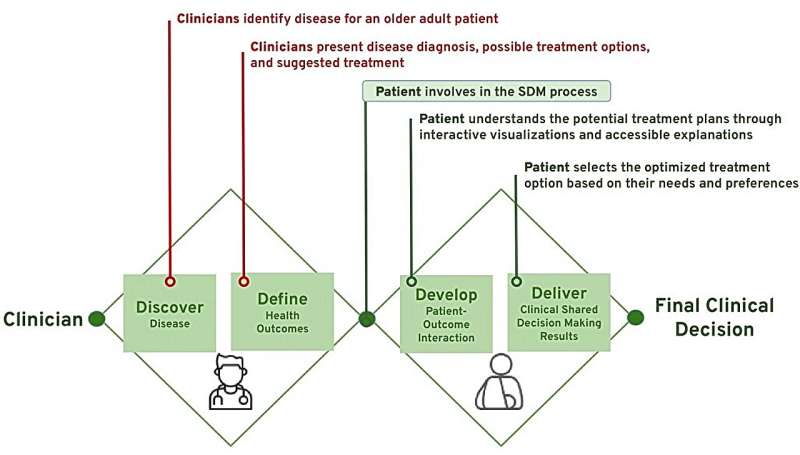This article has been reviewed according to Science X's editorial process and policies. Editors have highlighted the following attributes while ensuring the content's credibility:
fact-checked
trusted source
proofread
AI may improve doctor–patient interactions for older adults with cancer

Artificial intelligence has the potential to help older adults with cancer communicate with their doctors and participate more fully in decisions about their treatment, according to new Cornell research.
A team led by Yuexing Hao, a doctoral student in the field of human centered design, has developed an AI tool that uses machine learning and large language models to identify treatment options based on patients' diagnoses, demographic information and priorities.
Then it provides AI-generated information on each option's survival rates, potential side effects and risks, along with links to high-quality online support resources.
Initial testing indicates that the tool, called i-SDM, has the potential to improve communication between older adult cancer patients and clinicians, and promote patient engagement and compliance with the treatment plan.
"We found that AI can serve a decision support role by providing more context or explanation," Hao said. "The patient follows the clinician's guidance, but they understand the treatment plan better and why clinicians made a particular choice. At the same time, AI can help to translate the patient's needs to the clinicians."
She presented the paper, "Advancing Patient-Centered Shared Decision-Making with AI Systems for Older Adult Cancer Patients," at the Association of Computing Machinery's Conference on Human Factors in Computing Systems (CHI 2024) in Hawaii on May 14.
Hao started with a feasibility study, interviewing older adults with chronic illnesses and clinicians to understand their needs and how they make decisions about care. She worked with Bob Riter, the patient advocate for the Cornell Community Cancer Partnership, to recruit older adult cancer survivors and clinicians working in related fields. Riter, the former executive director of the Cancer Resource Center of the Finger Lakes and a cancer survivor, also shared his own experience.
"Making treatment decisions for early stage prostate cancer can be especially challenging because surgery, radiation therapy and active surveillance are all viable options for many patients," Riter said. "The shared decision-making model facilitates patient-physician communication and leads to decisions that more accurately reflect the patient's wishes."
He is a co-author of the paper, along with Zeyu Liu, a master's student in design and environmental analysis, and Saleh Kalantari, the Lois and Mel Tukman Assistant Professor in the Department of Human Centered Design in the College of Human Ecology.
Based on the initial interviews, Hao and the team identified 10 factors that participants thought were important to consider when deciding on a treatment plan. While both clinicians and patients listed information like five-year survival rates, potential risks and alternative treatment options, patients also mentioned several additional concerns, including how far they would need to travel to get the treatment and its cost.
They performed a second study with seven clinicians and 18 cancer survivors to evaluate the tool's usability and user perceptions about using AI in this way.
"Shared decision-making is often not practical in the clinical setting," Hao said. Doctors have limited time to spend with patients, and it's hard for patients without any medical background to fully understand the risks and benefits of treatment options.
Hao, who studies human-computer interactions and AI in health care, began this project after watching her elderly grandfather struggle to navigate his medical care. She decided to focus on older adults with cancer because they typically need to make complex decisions in a short period of time.
"We're opening a framework to see how AI can optimize clinical decision-making so it's evidence-based and step-wise," Hao said. "The i-SDM system doesn't replace skilled professionals. I'm interested in seeing how AI can improve human-human interactions."
One finding surprised Hao: Two patients and one clinician rejected the AI tool as well as the shared decision-making model itself, citing knowledge barriers and the risks of misinformation. She said it showed the value of conducting open-ended, qualitative research.
"As researchers, we often make assumptions about stakeholders," she said. "That's why we observe gaps between science and real practice. This kind of qualitative study, with real patient-survivors and real clinicians, helps us to frame future research."
The team is continuing to improve the tool. They're currently integrating a health equity component, addressing the challenges of applying findings from clinical trials with homogenous samples to broader, more diverse populations.
"The study focuses specifically on older adults with cancer, a demographic often overlooked in health care technology development," Kalantari said. "This emphasis is crucial as it addresses the unique challenges faced by this group, including a higher prevalence of comorbidities and lower technology literacy, which can complicate medical decision-making."
More information: Yuexing Hao et al, Advancing Patient-Centered Shared Decision-Making with AI Systems for Older Adult Cancer Patients, Proceedings of the CHI Conference on Human Factors in Computing Systems (2024). DOI: 10.1145/3613904.3642353

















